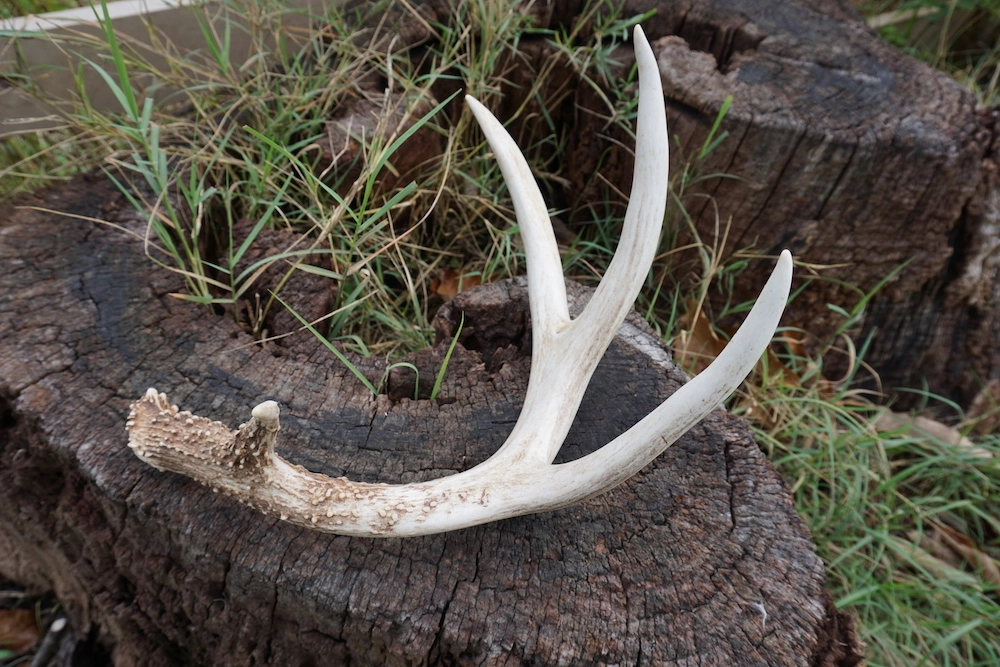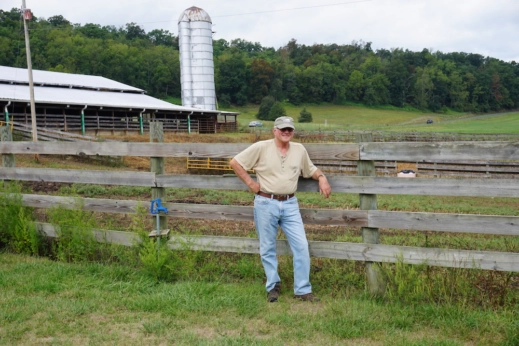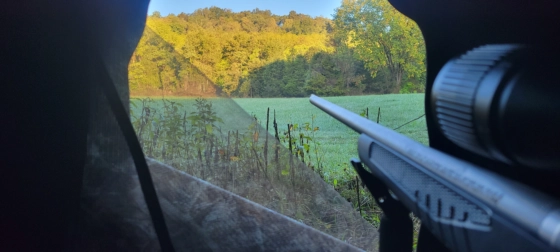With an abundance of deer spilling into suburban and agricultural land, hunting advocates say there’s never been a better time for humans to reclaim our role in the food chain.

“There’s too damn many and you can quote me on that,” says Larry Vance, referring to the 31 white-tailed deer he recently counted in a single cornfield at his family’s historic Island Ford Farm in Strasburg, Virginia.
It can be quite a problem sharing your land with deer when they’re eating up your profits, especially when, as Vance points out, they’ve adapted to humans and become fearless. Vance keeps a garden on the farm, which the deer routinely destroy. Deer also get into the feed his neighbor stores for his calves. And then there’s the cornfield, which his cousin Scott Stickley planted for livestock feed. “The crop insurance people will not give him insurance next year unless he gets kill permits,” says Vance, referring to the Virginia Department of Wildlife Resources (DWR) licenses to hunt so-called nuisance deer year-round.
For farmers with a deer problem, there’s a time-honored solution: hunting. Hunters can mitigate the damages to crops and property caused by the animals, whether it’s tearing into hay bales or damaging fence lines. Hunters can secure permission to pursue deer and other wildlife on private land and offer their services free of charge, relishing opportunities to hunt away from public land crowds.

Deer-damaged crops in Larry Vance’s cornfield in Strasburg, Virginia. (Photo: Heidi Chaya/Modern Farmer)
Like many farmers, Vance views hunting on his land as a privilege that must be earned. “They’ve got to prove to me they’re going to make use of the deer. It’s not target practice with a live target.” Making use of that deer has another benefit: The annual tradition puts meat on the table—and for food-insecure communities, game meat can make a big difference.
Hunting, for the hungry
The VA nonprofit organization Hunters for the Hungry (H4H) accepts donations of game—mostly deer—and coordinates distribution of the meat to people in need. “In the last five years, we’ve averaged 214,154 pounds and that’s over 850,000 servings annually to men, women, children, the elderly, the homeless and veterans that are facing food insecurity,” says Gary Arrington, director of H4H. Since its inception in 1991, the program has donated nearly 8 million pounds of venison (deer meat).
H4H is just one of many programs of its kind around the country that have become increasingly relevant in the wake of the pandemic, which has exacerbated issues of food affordability and access. H4H covers the cost of processing, storage and logistics for donated game, and food pantries and other facilities receive the meat at no cost. “[H4H] really helps to sustain the already strained budgets of these feeding programs, and it allows them to have this essential high-protein red meat for their clients, so they can also have healthy diets,” says Arrington.
Farmers provide a large percentage of H4H’s donated deer—often taken under DWR kill permits. And while Arrington adds that the DWR only requires that hunters properly dispose of nuisance deer—which can mean simply burying them or throwing them away—H4H’s network ensures they’re not wasted. “[Farmers] are really excited when they can call us, and that affords them the ability to harvest those deer, protect the crops and their livelihood, and we get those deer and use them to feed people,” says Arrington.
Benefits of hunting
Hunted nearly to extinction in the early 1900s, a decline in apex predators has helped deer populations in the US rebound to approximately 35 million to 36 million. Overpopulation puts deer in increasing contact with humans, sometimes with negative consequences. Deer account for a slew of fatal wildlife encounters every year, including vehicular collisions driving millions of auto insurance claims. Tick-borne diseases can be transmitted from deer to humans, and too many deer can allow bovine tuberculosis and Chronic Wasting Disease to spread readily.
Hunting can help reduce disease by managing deer population and unwanted human-animal interactions. It’s also vital to wildlife and habitat conservation. Hunters spend hundreds of millions of dollars annually on the pursuit. State and national wildlife organizations rely on these funds—derived from license fees and portions of the sales of equipment such as firearms and ammo. Hunting also drives tourism in many destinations, which in turn bolsters local economies. “Think of the investments that people make to hunt deer. [Venison] must be good. They put a lot of effort, resources and money into it,” says Vance.

“They’ve got to prove to me they’re going to make use of the deer. It’s not target practice with a live target,” says Virginia farmer Larry Vance. (Photo: Heidi Chaya/Modern Farmer)
And it is good: It’s high in protein, omega-3s and B vitamins and low in fat, with a broad appeal to consumers seeking healthier, more sustainable meat options. Wild game meat airs on the climate-friendly side, too. “The big carbon cost is however much it costs you to drive your car to your hunting spot and back,” says Nicole Meier, hunter education program coordinator for the Vermont Fish and Wildlife Department (VFWD). Game meat doesn’t need to be fed, housed or shipped. Often, dinner comes from just outside the hunter’s door.
Connecting a community
“The community culture of knowing where your food comes from is a huge thing,” says Meier. “It’s a real sense of pride to be able to directly provide for your family in such a concrete and real way. That’s an important piece to our connection to the landscape, the food system, to what we’re putting on our plate.”
An interest in self-sufficiency and food sovereignty motivates the fastest-growing segment of emergent hunters, millennials and women, says Meier—who herself began hunting after graduating college. Plus, it offers an opportunity to spend time outdoors. “I know that when I go into the woods, I feel better when I come out, whether or not I harvest something. It’s just healthy to be outside.”

The view from a hunting blind overlooking a field in Virginia. (Photo: Heidi Chaya/Modern Farmer)
State-run programs continue to prove effective in recruiting and retaining new hunters. The VFWD hosts Learn to Hunt workshops that offer hands-on instruction in firearms safety, basic survival skills and mentored hunts. “The Learn to Hunt programs are really crucial,” says Meier, “because, generally, new adult hunters don’t have any kind of support system to talk to about hunting, to ask questions—or just to reinforce that hunting is good and that you should be doing it.”
The VFWD also runs Women in the Outdoors events with the National Wild Turkey Federation and Vermont Wild Kitchen, a collaboration with the agricultural nonprofit Rural Vermont that features cooking workshops with locally grown and wild-sourced ingredients. “Because food is so universal…it’s really easy for us to use the Vermont Wild Kitchen program as an entry point to conversations about hunting, fishing and trapping, their importance in the food system and why wild food is local food,” says Meier.
Deer-hunting season across the country coincides with the winter holidays, which reinforces for some that hunting is about giving, not just taking life.
Back in rural Virginia, Adrian Guerrero, who’s been hunting private land for years, is already busy preparing venison jerky and tamales: gifts of gratitude. “To me, the most important part is to treat the land, animals and property with greater care and respect than as if it was yours. Become friends and not just the person the landowner sees during hunting season, and give back to the land owner or his family,” he says.
“We’re blessed to share,” says Arrington of H4H. “For every deer that we receive, we’re going to make a difference in somebody’s life.”
***
Learn more: For people looking to educate themselves about becoming a hunter, the US Fish & Wildlife Service’s Hunter Education Program funds state fish and wildlife agencies to provide instruction in firearm and archery safety, wildlife management, conservation, ethics, game laws, and wilderness survival and first aid. The quickest way to find a program in your area is to do a web search for “hunter education program” and the state or province you’re in.
Get involved: If you’re a hunter looking to donate meat, Farmers and Hunters Feeding the Hungry is a faith-based organization that maintains a database of deer and elk donation organizations and participating butchers.
Read next: The Struggle to Contain, and Eat, the Invasive Deer Taking over Hawaii
too many reindeers in america? 30+ million verses 332+ million people ,not including the illegals?
I should check to see if there are programs similar to what is described here in my state (Iowa). My wife and I have a young chestnut orchard and when production starts in earnest, deer will certainly become an issue. The fact she’s an Army vet dovetails nicely.